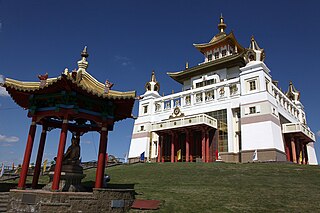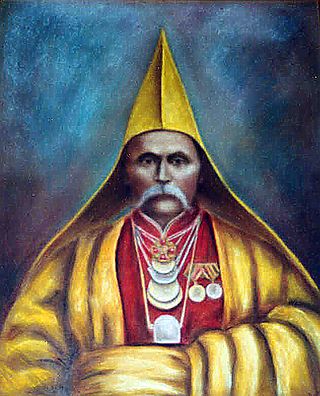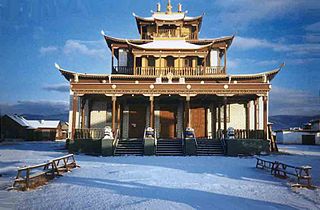
The Mongols are an East Asian ethnic group native to Mongolia, Inner Mongolia in China, and the Buryatia Republic of the Russian Federation. The Mongols are the principal member of the large family of Mongolic peoples. The Oirats in Western Mongolia as well as the Buryats and Kalmyks of Russia are classified either as distinct ethno-linguistic groups or subgroups of Mongols.

The Kalmyks are a Mongolic ethnic group living mainly in Russia, whose ancestors migrated from Dzungaria. They created the Kalmyk Khanate from 1635 to 1779 in the south of the European part of Russia territory. Today they form a majority in Kalmykia, located in the Kalmyk Steppe, on the western shore of the Caspian Sea.

The Dzungar Khanate, also written as the Zunghar Khanate, was an Inner Asian khanate of Oirat Mongol origin. At its greatest extent, it covered an area from southern Siberia in the north to present-day Kyrgyzstan in the south, and from the Great Wall of China in the east to present-day Kazakhstan in the west. The core of the Dzungar Khanate is today part of northern Xinjiang, also called Dzungaria.

Oirats or Oirds, also formerly Eluts and Eleuths, are the westernmost group of the Mongols whose ancestral home is in the Altai region of Siberia, Xinjiang and western Mongolia.

The Khalkha or Kalka have been the largest subgroup of Mongol people in modern Mongolia since the 15th century. The Khalkha, together with Chahars, Ordos and Tumed, were directly ruled by Borjigin khans until the 20th century; unlike the Oirats, who were ruled by Dzungar nobles or the Khorchins, who were ruled by Qasar's descendants.

Kalmykia, officially the Republic of Kalmykia, is a republic of Russia, located in the North Caucasus region of Southern Russia. The republic is part of the Southern Federal District, and borders Dagestan to the south and Stavropol Krai to the southwest; Volgograd Oblast to the northwest and north and Astrakhan Oblast to the north and east; Rostov Oblast to the west and the Caspian Sea to the east. Kalmykia is the only region in Europe where Buddhism is the predominant religion.

Pugachev's Rebellion of 1773–1775 was the principal revolt in a series of popular rebellions that took place in the Russian Empire after Catherine II seized power in 1762. It began as an organized insurrection of Yaik Cossacks headed by Yemelyan Pugachev, a disaffected ex-lieutenant of the Imperial Russian Army, against a background of profound peasant unrest and war with the Ottoman Empire. After initial success, Pugachev assumed leadership of an alternative government in the name of the late Tsar Peter III and proclaimed an end to serfdom. This organized leadership presented a challenge to the imperial administration of Catherine II.

The Kalmyk people are the only Mongolic-speaking people of Europe whose national religion is Buddhism. In 2016, 53.4% of the population surveyed identified themselves as Buddhist. They live in Kalmykia, a federal subject of the Russian Federation located in southwestern Russia. The border faces Dagestan to the south, Stavropol Krai to the southwest, Rostov Oblast to the west, Volgograd Oblast to the northwest and Astrakhan Oblast to the east. The Caspian Sea borders Kalmykia to the southeast.

Ja Lama was an adventurer and warlord of unknown birth and background who fought successive campaigns against the rule of the Qing dynasty in western Mongolia between 1890 and 1922. He claimed to be a Buddhist lama, though it is not clear whether he actually was one, as well as a grandson and later the reincarnation of Amursana, the Khoid-Oirat prince who led the last great Mongol uprising against the Qing in 1757. He was one of the commanders of Mongolian forces that liberated Khovd city from Qing control in 1912.

Lubsan Sharab Tepkin (1875–1941?) was a Buddhist priest of Kalmyk origin who was born in the Bokshirgankan aimak in the Salsk District of the Don Cossack Host sometime in 1875.

Menko Bormanzhinov was a Buddhist priest of Kalmyk origin who was born in the Bokshirgankan aimak in the Salsk District of the Don Cossack Host sometime in 1855.

Shurguchi Nimgirov was a Buddhist priest of Kalmyk origin who was born in the Bayuda aimak in the Salsk District of the Don Cossack Host.

Ivan Bultinovich Kitanov (1858-1926) was a Buddhist priest of Kalmyk origin who was born in the Beliavin aimak in the Salsk District of the Don Cossack Host.

Arkad Chubanov (1840–1894) was a Buddhist priest of Kalmyk origin who was born in the Iki-Burul aimak in the Salsk District of the Don Cossack Host sometime in 1840.

Pan-Mongolism is an irredentist idea that advocates cultural and political solidarity of Mongols. The proposed territory, called "Greater Mongolia", also known as "Хамаг Монгол" usually includes the independent state of Mongolia, the Chinese region of Inner Mongolia, and the Russian region of Buryatia. Sometimes the autonomous republic Tuva, the Altai Republic and parts of Xinjiang, Zabaykalsky Krai, and Irkutsk Oblast are included as well. As of 2006, all areas in Greater Mongolia except Mongolia have non-Mongol majorities.

The Bukey Horde, also known as the Inner Horde or Interior Horde, was an autonomous khanate of Kazakhs located north of the Caspian Sea in between the Ural and Volga Rivers, but never reaching these rivers. The khanate officially existed from 1801 to 1845, when the position of khan was abolished and the area was fully absorbed into the administration of the Russian Empire. It was located in the western part of modern-day Kazakhstan. Its lands were spread over about 71,000 square kilometers.

The Mongolian Revolution of 1911 occurred when the region of Outer Mongolia declared its independence from the Manchu-led Qing China during the Xinhai Revolution. A combination of factors, including economic hardship and failure to resist Western imperialism, led many in China to be unhappy with the Qing government. When a new program to settle Mongolia with ethnic Han and assimilate the natives was unveiled, it was met with resistance that resulted in a relatively bloodless separation from the Qing Empire. Many Barga and Inner Mongolian chieftains assisted in the revolution and became the revolution leaders.

Historically, Buddhism was incorporated into Siberia in the early 17th century. Buddhism is considered to be one of Russia's traditional religions and is legally a part of Russian historical heritage. Besides the historical monastic traditions of Buryatia, Tuva and Kalmykia, the religion of Buddhism is now spreading all over Russia, with many ethnic Russian converts.

The Kalmyk Khanate was an Oirat khanate on the Eurasian steppe. It extended over modern Kalmykia and surrounding areas in the North Caucasus, including Stavropol and Astrakhan. During their independence, the Kalmyks both raided and allied with Russia in turn, engaging in numerous military expeditions against the Crimean Tatars, the Ottoman Empire, neighboring Muslim tribes, and the highlanders of the North Caucasus. The Khanate was annexed by the Russian Empire in 1771.
Anti-Mongol sentiment has been prevalent throughout history, often perceiving the Mongols to be barbaric and uncivilized people with a lack of intelligence or civilized culture.



















